Nursing Assessment in Angioplasty: Clinical Simulation Report
VerifiedAdded on 2023/01/18
|6
|1268
|51
Report
AI Summary
This report presents a case study of Mr. Harry Bright, who underwent angioplasty due to angina, and analyzes the nursing assessments conducted during a clinical simulation. It evaluates the accuracy of the nurse's actions, such as pain assessment and monitoring of vital signs (ECG, blood pressure, pulse rate), while highlighting assessments that were missed, including neurological evaluations, arrhythmia signs, and puncture site assessments for bleeding or hematoma. The report emphasizes the importance of comprehensive patient monitoring, referencing contemporary research to support the need for thorough assessment of potential complications like ischemic stroke, retroperitoneal bleeding, and infection. It stresses the significance of adherence to nursing standards and best practices for effective post-angioplasty care and patient safety. The assignment uses five research articles to support its findings and recommendations for improving nursing practice.
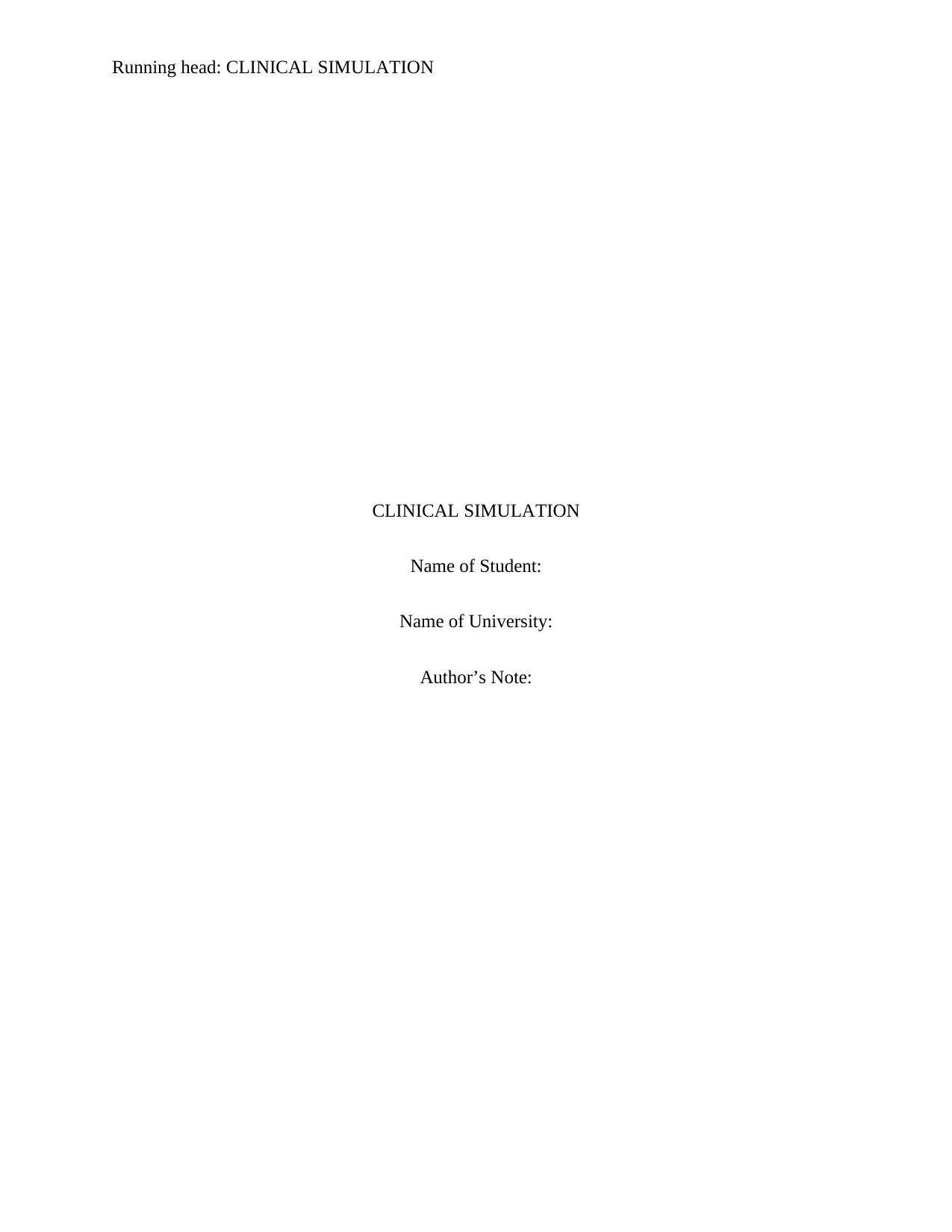
Running head: CLINICAL SIMULATION
CLINICAL SIMULATION
Name of Student:
Name of University:
Author’s Note:
CLINICAL SIMULATION
Name of Student:
Name of University:
Author’s Note:
Paraphrase This Document
Need a fresh take? Get an instant paraphrase of this document with our AI Paraphraser

1CLINICAL SIMULATION
The paper outline the case study of Mr Harry Bright who was suffering from angina and
because of this he has underwent angioplasty. The paper highlights the assessment done by the
nurse during clinical simulation further also deals about assessment which needs to be done by
them.
Nursing assessment done by nurse in process of simulation:
In reference with the critical evaluation of nursing care given to the patient post
angioplasty, following assessment conducted by the nurse are correct.
During the simulation process, nurse have done pain assessment by providing effective
medication Nitroglycerin. Patient who has undergone angioplasty generally tends to have
chest pain due to failure in flow of oxygenated blood in heart, which need to be assessed
by the nurse. Nitroglycerin is one of the effective medicine as it is known to increase the
flow of blood into the heart. It also reduces the resistance of vascular vessel in heart
therefore the passage of oxygenated blood takes places efficiently. Moreover,
administration of such medicine is used to control the blood pressure in heart hence,
reduce the occurrence of ischemia stroke in patient who have undergone angioplasty
(Pragani et al., 2017).
Second assessment done by the nurse was observing the physical functioning of the body.
ECG, Blood Pressure and Pulse Rate was noted by the nurse during the simulation of
patient. It is important to monitor the functioning of heart as this will reduce the chance
of ischemia stroke. ECG gives the information of systole and diastole of the heart and
reveal the status of blood flow into it (Sinha et al., 2017). Monitoring of Blood Pressure
and Pulse Rate will say about the rate at which the blood is flowing into the heart and
The paper outline the case study of Mr Harry Bright who was suffering from angina and
because of this he has underwent angioplasty. The paper highlights the assessment done by the
nurse during clinical simulation further also deals about assessment which needs to be done by
them.
Nursing assessment done by nurse in process of simulation:
In reference with the critical evaluation of nursing care given to the patient post
angioplasty, following assessment conducted by the nurse are correct.
During the simulation process, nurse have done pain assessment by providing effective
medication Nitroglycerin. Patient who has undergone angioplasty generally tends to have
chest pain due to failure in flow of oxygenated blood in heart, which need to be assessed
by the nurse. Nitroglycerin is one of the effective medicine as it is known to increase the
flow of blood into the heart. It also reduces the resistance of vascular vessel in heart
therefore the passage of oxygenated blood takes places efficiently. Moreover,
administration of such medicine is used to control the blood pressure in heart hence,
reduce the occurrence of ischemia stroke in patient who have undergone angioplasty
(Pragani et al., 2017).
Second assessment done by the nurse was observing the physical functioning of the body.
ECG, Blood Pressure and Pulse Rate was noted by the nurse during the simulation of
patient. It is important to monitor the functioning of heart as this will reduce the chance
of ischemia stroke. ECG gives the information of systole and diastole of the heart and
reveal the status of blood flow into it (Sinha et al., 2017). Monitoring of Blood Pressure
and Pulse Rate will say about the rate at which the blood is flowing into the heart and
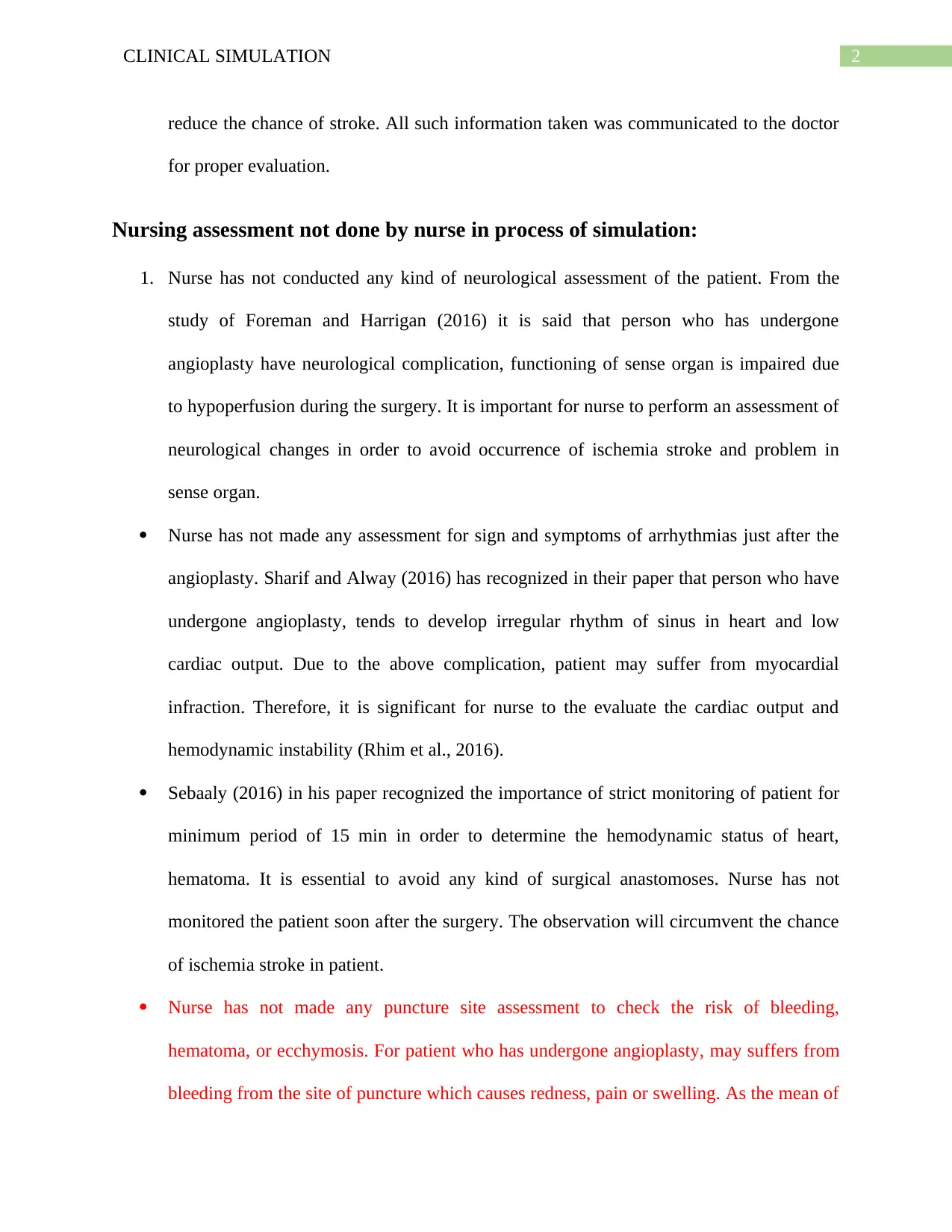
2CLINICAL SIMULATION
reduce the chance of stroke. All such information taken was communicated to the doctor
for proper evaluation.
Nursing assessment not done by nurse in process of simulation:
1. Nurse has not conducted any kind of neurological assessment of the patient. From the
study of Foreman and Harrigan (2016) it is said that person who has undergone
angioplasty have neurological complication, functioning of sense organ is impaired due
to hypoperfusion during the surgery. It is important for nurse to perform an assessment of
neurological changes in order to avoid occurrence of ischemia stroke and problem in
sense organ.
Nurse has not made any assessment for sign and symptoms of arrhythmias just after the
angioplasty. Sharif and Alway (2016) has recognized in their paper that person who have
undergone angioplasty, tends to develop irregular rhythm of sinus in heart and low
cardiac output. Due to the above complication, patient may suffer from myocardial
infraction. Therefore, it is significant for nurse to the evaluate the cardiac output and
hemodynamic instability (Rhim et al., 2016).
Sebaaly (2016) in his paper recognized the importance of strict monitoring of patient for
minimum period of 15 min in order to determine the hemodynamic status of heart,
hematoma. It is essential to avoid any kind of surgical anastomoses. Nurse has not
monitored the patient soon after the surgery. The observation will circumvent the chance
of ischemia stroke in patient.
Nurse has not made any puncture site assessment to check the risk of bleeding,
hematoma, or ecchymosis. For patient who has undergone angioplasty, may suffers from
bleeding from the site of puncture which causes redness, pain or swelling. As the mean of
reduce the chance of stroke. All such information taken was communicated to the doctor
for proper evaluation.
Nursing assessment not done by nurse in process of simulation:
1. Nurse has not conducted any kind of neurological assessment of the patient. From the
study of Foreman and Harrigan (2016) it is said that person who has undergone
angioplasty have neurological complication, functioning of sense organ is impaired due
to hypoperfusion during the surgery. It is important for nurse to perform an assessment of
neurological changes in order to avoid occurrence of ischemia stroke and problem in
sense organ.
Nurse has not made any assessment for sign and symptoms of arrhythmias just after the
angioplasty. Sharif and Alway (2016) has recognized in their paper that person who have
undergone angioplasty, tends to develop irregular rhythm of sinus in heart and low
cardiac output. Due to the above complication, patient may suffer from myocardial
infraction. Therefore, it is significant for nurse to the evaluate the cardiac output and
hemodynamic instability (Rhim et al., 2016).
Sebaaly (2016) in his paper recognized the importance of strict monitoring of patient for
minimum period of 15 min in order to determine the hemodynamic status of heart,
hematoma. It is essential to avoid any kind of surgical anastomoses. Nurse has not
monitored the patient soon after the surgery. The observation will circumvent the chance
of ischemia stroke in patient.
Nurse has not made any puncture site assessment to check the risk of bleeding,
hematoma, or ecchymosis. For patient who has undergone angioplasty, may suffers from
bleeding from the site of puncture which causes redness, pain or swelling. As the mean of
⊘ This is a preview!⊘
Do you want full access?
Subscribe today to unlock all pages.

Trusted by 1+ million students worldwide
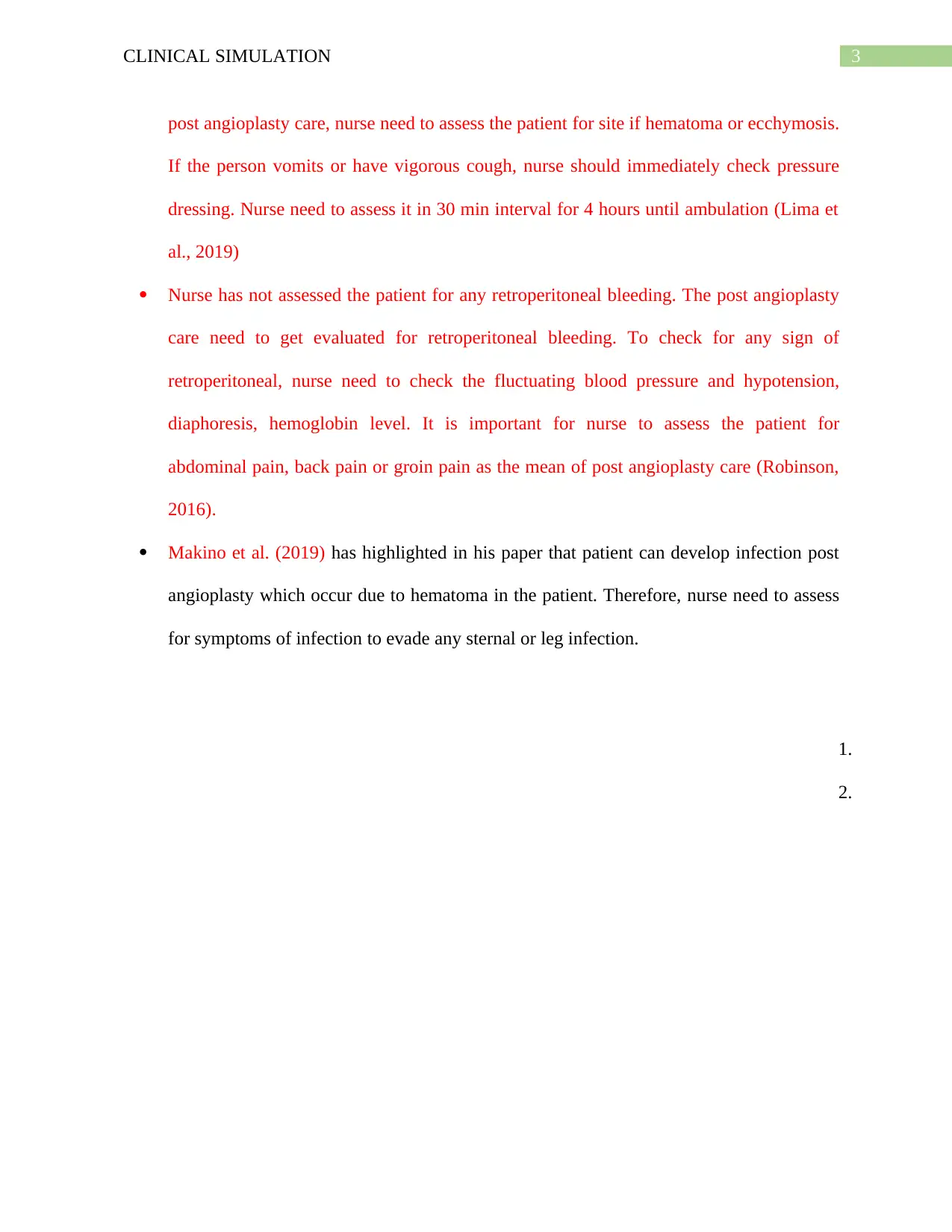
3CLINICAL SIMULATION
post angioplasty care, nurse need to assess the patient for site if hematoma or ecchymosis.
If the person vomits or have vigorous cough, nurse should immediately check pressure
dressing. Nurse need to assess it in 30 min interval for 4 hours until ambulation (Lima et
al., 2019)
Nurse has not assessed the patient for any retroperitoneal bleeding. The post angioplasty
care need to get evaluated for retroperitoneal bleeding. To check for any sign of
retroperitoneal, nurse need to check the fluctuating blood pressure and hypotension,
diaphoresis, hemoglobin level. It is important for nurse to assess the patient for
abdominal pain, back pain or groin pain as the mean of post angioplasty care (Robinson,
2016).
Makino et al. (2019) has highlighted in his paper that patient can develop infection post
angioplasty which occur due to hematoma in the patient. Therefore, nurse need to assess
for symptoms of infection to evade any sternal or leg infection.
1.
2.
post angioplasty care, nurse need to assess the patient for site if hematoma or ecchymosis.
If the person vomits or have vigorous cough, nurse should immediately check pressure
dressing. Nurse need to assess it in 30 min interval for 4 hours until ambulation (Lima et
al., 2019)
Nurse has not assessed the patient for any retroperitoneal bleeding. The post angioplasty
care need to get evaluated for retroperitoneal bleeding. To check for any sign of
retroperitoneal, nurse need to check the fluctuating blood pressure and hypotension,
diaphoresis, hemoglobin level. It is important for nurse to assess the patient for
abdominal pain, back pain or groin pain as the mean of post angioplasty care (Robinson,
2016).
Makino et al. (2019) has highlighted in his paper that patient can develop infection post
angioplasty which occur due to hematoma in the patient. Therefore, nurse need to assess
for symptoms of infection to evade any sternal or leg infection.
1.
2.
Paraphrase This Document
Need a fresh take? Get an instant paraphrase of this document with our AI Paraphraser
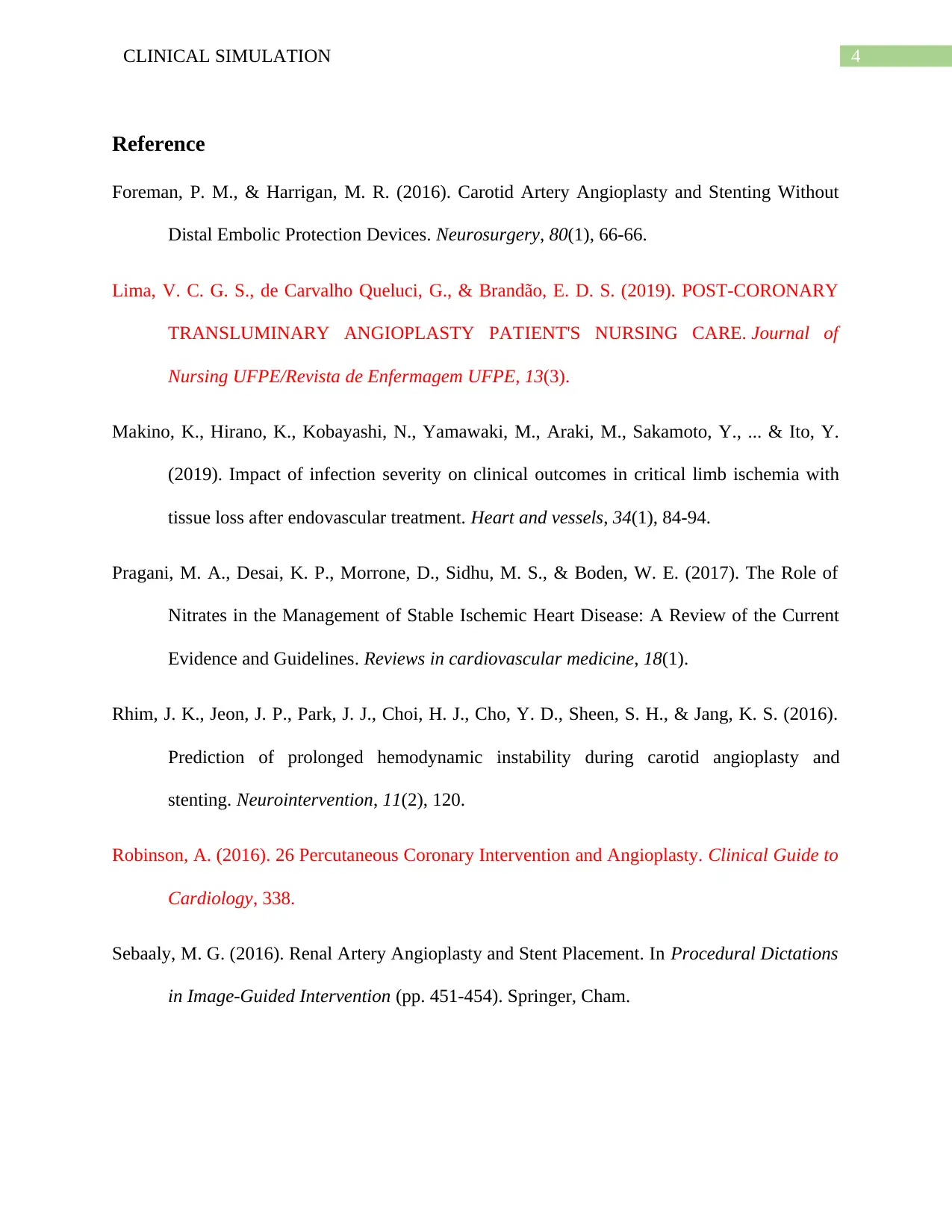
4CLINICAL SIMULATION
Reference
Foreman, P. M., & Harrigan, M. R. (2016). Carotid Artery Angioplasty and Stenting Without
Distal Embolic Protection Devices. Neurosurgery, 80(1), 66-66.
Lima, V. C. G. S., de Carvalho Queluci, G., & Brandão, E. D. S. (2019). POST-CORONARY
TRANSLUMINARY ANGIOPLASTY PATIENT'S NURSING CARE. Journal of
Nursing UFPE/Revista de Enfermagem UFPE, 13(3).
Makino, K., Hirano, K., Kobayashi, N., Yamawaki, M., Araki, M., Sakamoto, Y., ... & Ito, Y.
(2019). Impact of infection severity on clinical outcomes in critical limb ischemia with
tissue loss after endovascular treatment. Heart and vessels, 34(1), 84-94.
Pragani, M. A., Desai, K. P., Morrone, D., Sidhu, M. S., & Boden, W. E. (2017). The Role of
Nitrates in the Management of Stable Ischemic Heart Disease: A Review of the Current
Evidence and Guidelines. Reviews in cardiovascular medicine, 18(1).
Rhim, J. K., Jeon, J. P., Park, J. J., Choi, H. J., Cho, Y. D., Sheen, S. H., & Jang, K. S. (2016).
Prediction of prolonged hemodynamic instability during carotid angioplasty and
stenting. Neurointervention, 11(2), 120.
Robinson, A. (2016). 26 Percutaneous Coronary Intervention and Angioplasty. Clinical Guide to
Cardiology, 338.
Sebaaly, M. G. (2016). Renal Artery Angioplasty and Stent Placement. In Procedural Dictations
in Image-Guided Intervention (pp. 451-454). Springer, Cham.
Reference
Foreman, P. M., & Harrigan, M. R. (2016). Carotid Artery Angioplasty and Stenting Without
Distal Embolic Protection Devices. Neurosurgery, 80(1), 66-66.
Lima, V. C. G. S., de Carvalho Queluci, G., & Brandão, E. D. S. (2019). POST-CORONARY
TRANSLUMINARY ANGIOPLASTY PATIENT'S NURSING CARE. Journal of
Nursing UFPE/Revista de Enfermagem UFPE, 13(3).
Makino, K., Hirano, K., Kobayashi, N., Yamawaki, M., Araki, M., Sakamoto, Y., ... & Ito, Y.
(2019). Impact of infection severity on clinical outcomes in critical limb ischemia with
tissue loss after endovascular treatment. Heart and vessels, 34(1), 84-94.
Pragani, M. A., Desai, K. P., Morrone, D., Sidhu, M. S., & Boden, W. E. (2017). The Role of
Nitrates in the Management of Stable Ischemic Heart Disease: A Review of the Current
Evidence and Guidelines. Reviews in cardiovascular medicine, 18(1).
Rhim, J. K., Jeon, J. P., Park, J. J., Choi, H. J., Cho, Y. D., Sheen, S. H., & Jang, K. S. (2016).
Prediction of prolonged hemodynamic instability during carotid angioplasty and
stenting. Neurointervention, 11(2), 120.
Robinson, A. (2016). 26 Percutaneous Coronary Intervention and Angioplasty. Clinical Guide to
Cardiology, 338.
Sebaaly, M. G. (2016). Renal Artery Angioplasty and Stent Placement. In Procedural Dictations
in Image-Guided Intervention (pp. 451-454). Springer, Cham.
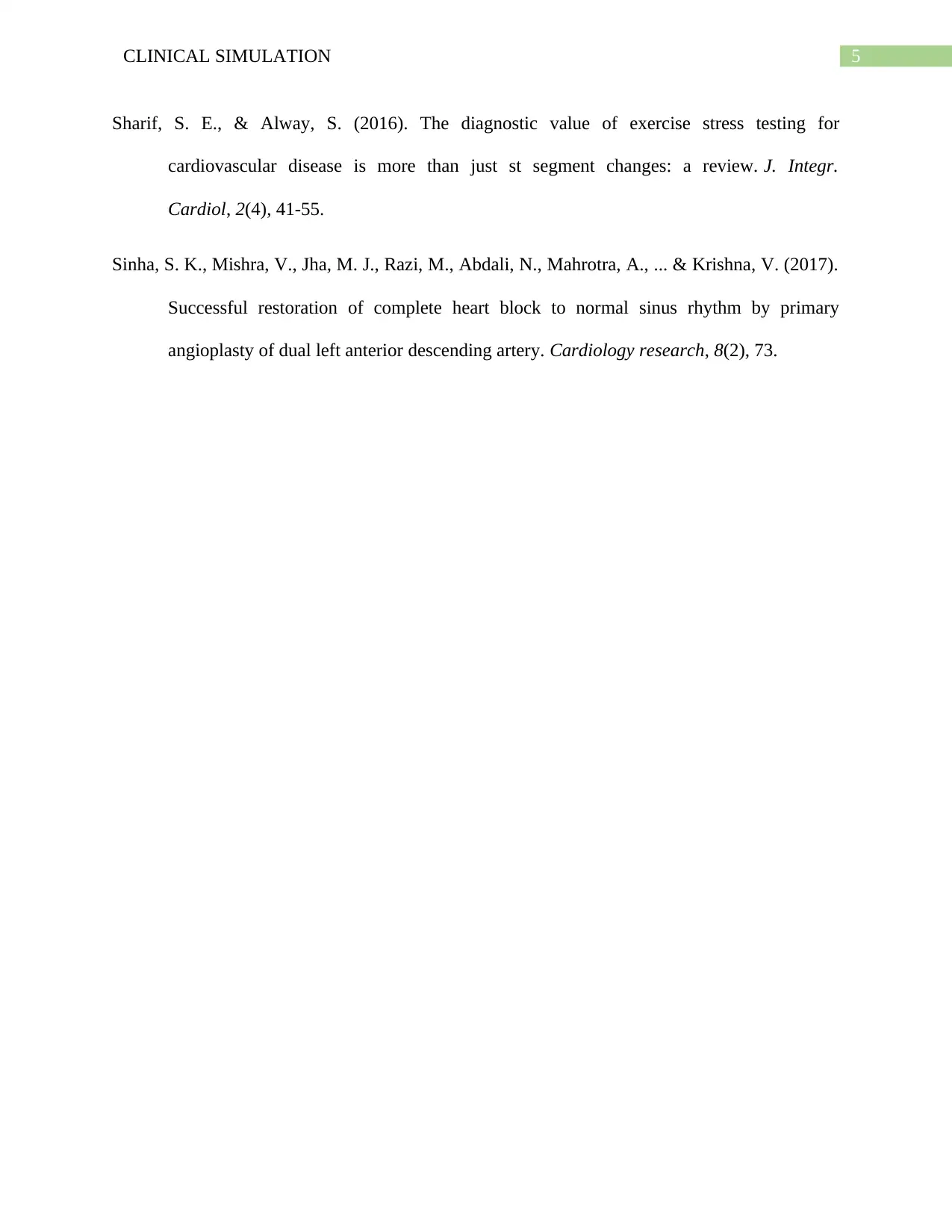
5CLINICAL SIMULATION
Sharif, S. E., & Alway, S. (2016). The diagnostic value of exercise stress testing for
cardiovascular disease is more than just st segment changes: a review. J. Integr.
Cardiol, 2(4), 41-55.
Sinha, S. K., Mishra, V., Jha, M. J., Razi, M., Abdali, N., Mahrotra, A., ... & Krishna, V. (2017).
Successful restoration of complete heart block to normal sinus rhythm by primary
angioplasty of dual left anterior descending artery. Cardiology research, 8(2), 73.
Sharif, S. E., & Alway, S. (2016). The diagnostic value of exercise stress testing for
cardiovascular disease is more than just st segment changes: a review. J. Integr.
Cardiol, 2(4), 41-55.
Sinha, S. K., Mishra, V., Jha, M. J., Razi, M., Abdali, N., Mahrotra, A., ... & Krishna, V. (2017).
Successful restoration of complete heart block to normal sinus rhythm by primary
angioplasty of dual left anterior descending artery. Cardiology research, 8(2), 73.
⊘ This is a preview!⊘
Do you want full access?
Subscribe today to unlock all pages.

Trusted by 1+ million students worldwide
1 out of 6
Related Documents
Your All-in-One AI-Powered Toolkit for Academic Success.
+13062052269
info@desklib.com
Available 24*7 on WhatsApp / Email
![[object Object]](/_next/static/media/star-bottom.7253800d.svg)
Unlock your academic potential
Copyright © 2020–2025 A2Z Services. All Rights Reserved. Developed and managed by ZUCOL.




